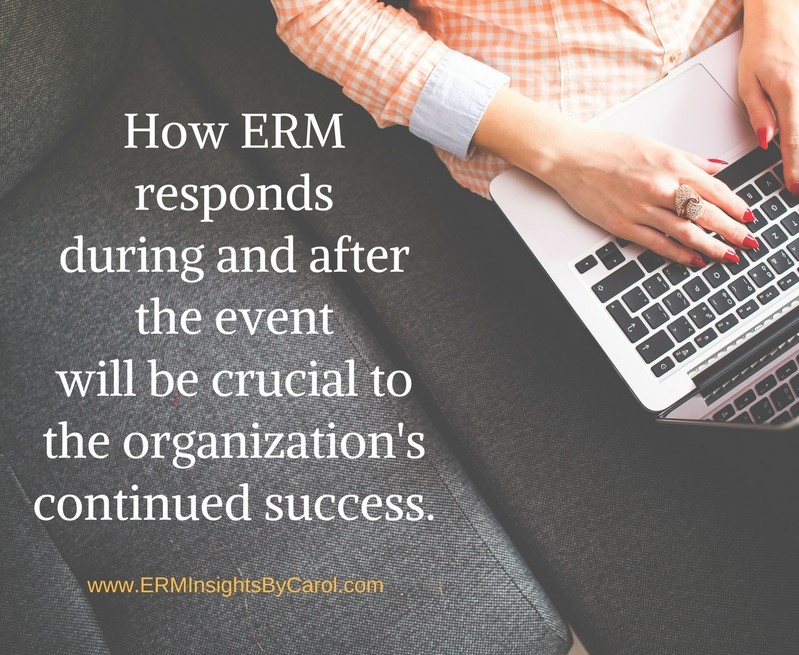Everyone’s afraid of something. Most people seem to be afraid of normal things, like clowns, spiders, or public speaking. But for risk managers, our greatest fear is that all of our hard work will be for nothing. The risks we worked so hard to identify, assess, and report—the known and the unknown, the black swans and the meteors—will become a reality. Then, we’ll have to answer the dreaded questions: “Why did this happen?” and “Where did ERM fail?”
Don’t let this scenario keep you up at night! While it’s possible some risks will become events, the best response is to plan ahead. Here are some practical steps you can take before and after an event.
Before the Risk Event:
1. Focus on Your Purpose: The purpose of ERM is to help senior management (including executives and the board) make risk-informed decisions. However, it is not your role to make management’s decisions for them. Nor is it in your power to block risk events from occurring. (You are not the CEO or Superman. Sorry.) Instead, focus your resources on developing a bank of usable risk information. (Read more: Enterprise Risk Management as a Strategic Tool for Companies.)
2. Communicate Your Purpose: It’s not enough for you to know your role in the organization; everyone else needs to know it, too. Communicate your purpose clearly and consistently, especially to senior management. Make sure they’re aware that you support their decision-making process. (Read more: 4 Risk Response Strategies You Will Have to Consider After Assessing Risks.)
3. Share Your Risk Information: The role of senior management is to manage, and that involves daily decision-making on a wide range of topics. No matter how integrated ERM is in the strategic planning process and the daily operations, you will not be included in every meeting (nor should you be). But your risk information can!
Make sure risk information is posted on your internal portal or drive so it can be downloaded by management and staff. (This could be a streamlined presentation, or even a Top Risk Dashboard, depending on your organization’s needs.) Also, forward the information to senior management regularly to make sure they are as familiar with the current risks as possible. Then, when they go to make decisions, they’ll be able to consider the impact to the organization’s known risks. (Read more: The “Next Frontier” of Enterprise Risk Management—From Compliance to Strategy.)
After the Risk Event:
Some risks will become events—that’s just the nature of risks. But how ERM responds during and after the event will be crucial to the organization’s continued success.
1. Look Ahead: Determine how the event affects other potential risks to the organization. For example, a large lawsuit is filed against the company as a result of a faulty product. ERM should work with the appropriate business units, including Product Development and Legal, to determine if the lawsuit could lead to a product recall, and how that could negatively affect the company’s reputation and finances. Management will be busy determining how to respond to the current crisis; ERM will need to help management get in front of the crisis by identifying the impacts downstream.
2. Learn Some Lessons: Work with the appropriate business units to identify the root cause and trigger for the risk event. Did it seem to come out of nowhere, or were there warning signs? Help identify Lessons Learned, focusing on ways to avoid, mitigate, or transfer the risk in the future. Report this new information to senior management as soon as possible so they consider it when making decisions going forward.
3. Don’t Say It: Sometimes, you’ll see the risk coming a mile away. You’ll warn all the appropriate people, and even advise on ways to avoid the risk, and yet the risk event will still occur. The absolute worst thing you can do is to say “I told you so.” You will never gain supporters this way.
However, as part of the Lessons Learned activity, you can identify if relevant risk information was overlooked or ignored. If so, was it unclear or vague? Were there competing opinions that outweighed it? It’s appropriate to identify what happened; just be professional in how you handle those discussions and the resulting information.
4. Seize the Opportunity: No, it won’t seem like an opportunity, but this will be the perfect time to expand your risk network and cultivate a positive risk culture. Why? Because everyone will have “risk” on the brain! They’ll be trying to determine what went wrong and how to prevent it in the future. Don’t get defensive when these questions arise. Simply seize the opportunity to reiterate the importance of continued ongoing risk management. Identify others throughout the organization who understand, and bring them into your risk network. And, if you really need it, ask for more staff or more time to discuss risks, or better technology—whatever you need to help the organization prepare for the future. (Read more: 5 Critical Steps to Cultivating a Positive Risk Culture.)
No matter how proactive ERM is, risk events will occur. But that doesn’t mean ERM has failed! Stay focused on your role within the organization and continue to give senior management the risk information they need to make the best possible decisions. If you can provide that kind of value, you’ll have nothing to fear…even if your black swans come in for a landing.
Have you seen any identified risks become events? If so, how did you handle the impact and what was the ultimate outcome?
We invite you to share your experience(s) in the comment section below or join the conversation on LinkedIn.
Continue browsing ERMInsightsbyCarol.com and don’t hesitate to contact me to discuss your organization’s risks and how you can prepare and respond to risk events.
About the author
Ashley Jones joined ERM Insights by Carol in June 2017. She graduated from Florida State University in 2003 with a B.A. in Risk Management and Insurance and obtained the Project Management Professional (PMP) designation in May 2012. Ashley has fourteen years of experience in the fields of insurance and risk management, most notably as a Senior Risk Analyst within the ERM department of a $7+ billion property and casualty insurance company. When she’s not working on project or risk management, Ashley is busy writing and blogging on a wide variety of topics.









